1
Rolling through spectacular Myra Canyon on the "Kettle Valley Line"Circa 1920
Myra Canyon, Kettle Valley Railway
 Credits:
Credits:Kettle River Museum
2
In 1910 the Canadian Pacific Railway was granted a right-of-way to build a new railway from 'Mile 0' at Midway west to Hope, the Kettle Valley Railway.But the sound of the hammer only came after exhaustive surveying and after chief engineer Andrew McCulloch had devised his plan. The building of the KVR is legendary for overcoming the ruggedness of the terrain it passed through and would become popularly known as 'McCullough's Wonder'.
In the Myra Canyon the KVR line had to drop 3,000 feet within a distance of fifteen miles. Twenty major wooden trestles in a space of six miles would be needed to span the canyon's ravines and traverse its sheer walls. The route through the Coguihalla Canyon faced similar challenges, compounded by severe winter conditions.
Against all odds the Kettle Valley Railway was completed in record time and brought change to the Boundary region of southern British Columbia like never before.
3
KVR passenger train at Mile 87.9, Canyon Creek, Myra CanyonJuly 1924
Carmi Subdivision, Kettle Valley Railway
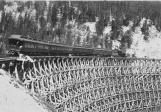 Credits:
Credits:Courtesy of Joe Smuin
4
Ladner Creek Trestle in the Coquihala Subdivision - 560' high on a 12° 36' curve1912-1916
Coquihalla Subdivision, Kettle Valley Railway
 Credits:
Credits:Kettle River Museum
5
"Although some maps show the Kettle Valley Railway line as extending from Vancouver to Medicine Hat, in actual fact the name applies only to that part of the line between Midway and Odlum, near Hope.However, the line from Vancouver to Medicine Hat became known as the 'Kettle Valley Line', partly because one could remain on the same train over the route and because of the mystique that arose over the engineering feat that the section officially known as the KVR was."
- from "A Farewell Trip on the KVR" by Kathleen S. Dewdney, Boundary Historical Society 5th Report, 1967.
6
Kettle Valley Railway route, from 'Mile 0' at Midway to Odlum near Hope in the west1915-
Southern British Columbia
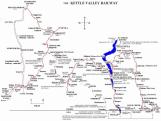 Credits:
Credits:Map by Joe Smuin
Courtesy of Joe Smuin
7
Building the KVR, by Andrew McCullough - Part I1938
Penticton, BC
 Credits:
Credits:Boundary Historical Society 4th Report, 1964
Read by Jack Godwin
8
Building the railway grade west, by hand and horse power1911-1915
Carmi Subdivision, Kettle Valley Railway
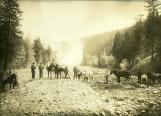 Credits:
Credits:Penticton Museum & Archives
9
KVR construction crew; the railway employed more than 5,000 workers at its peak1911-1915
Carmi Subdivision, Kettle Valley Railway
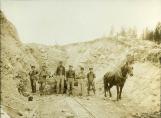 Credits:
Credits:Penticton Museum & Archives
10
Track-laying work train and crewCirca 1913
Princeton Subdivision, Kettle Valley Railway
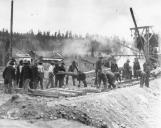 Credits:
Credits:Kettle River Museum
12
Ties for the railway were hand hewn and cut in the region. The Midway to Penticton section alone used more than half a million."In the days before sawmills became an accepted method of manufacturing, lumber and railroad ties were hand hewn with a broadax. Men would build a small temporary cabin near a stand of timber the right dimension for a railroad tie when hewn. They stood on the tree and scored to the depth needed for the finished face with the double-bitted axe, then used the broadax to slice off the scoring. This procedure was duplicated on the tree's other side.
When a log with several tie lengths was ready, a start was made on another tree, and when a load was made up they hauled it to a landing where the strings were bucked into eight-foot lengths. The ties were hauled to sidings for the Kettle Valley Railway."
- from "Harvest of Memories - Reminiscences of Bill Hatton"
13
A load of ties for the KVR wait at a siding1911-1915
Carmi Subdivision, Kettle Valley Railway
 Credits:
Credits:Courtesy of Cecelia Bourgeois
14
Laying ballast on the KVR1911-1915
Carmi Subdivision, Kettle Valley Railway
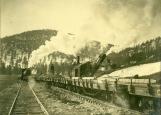 Credits:
Credits:Penticton Museum & Archives
